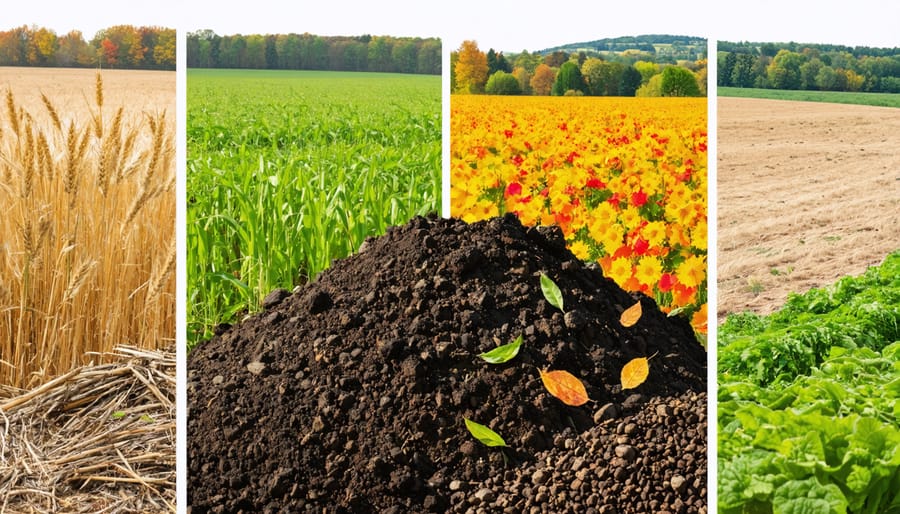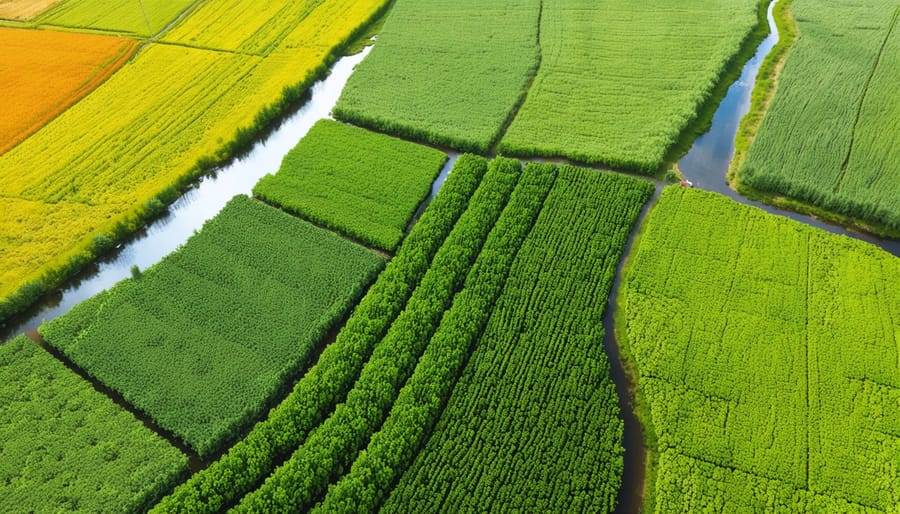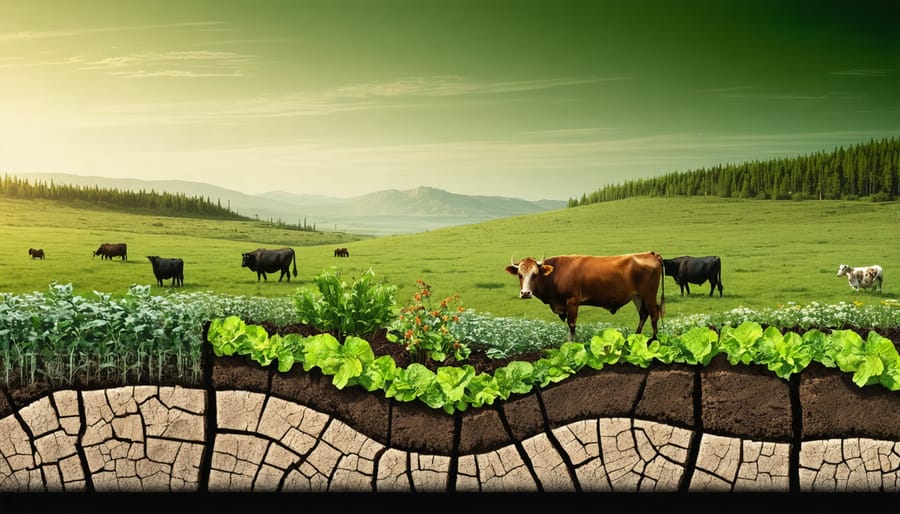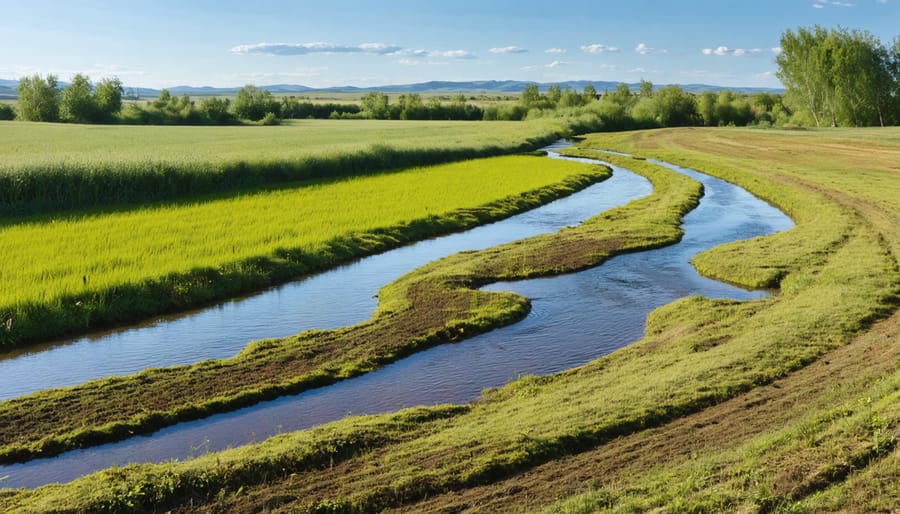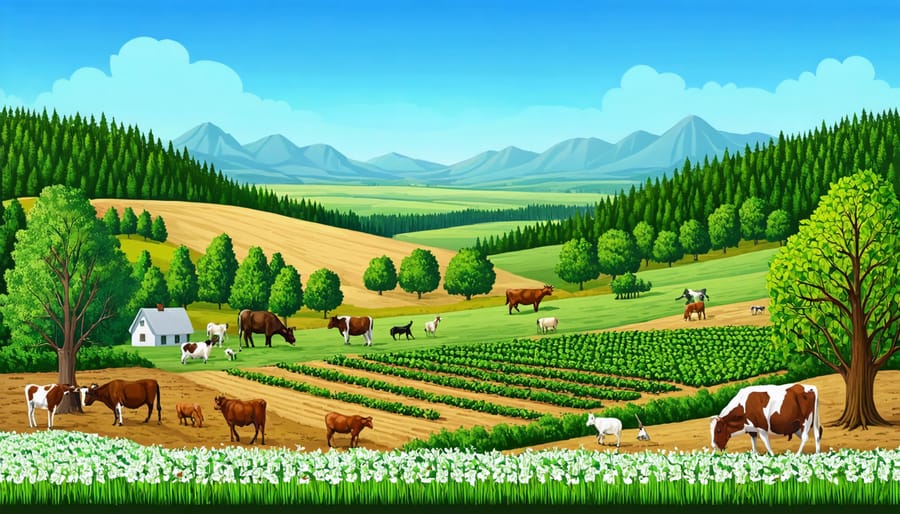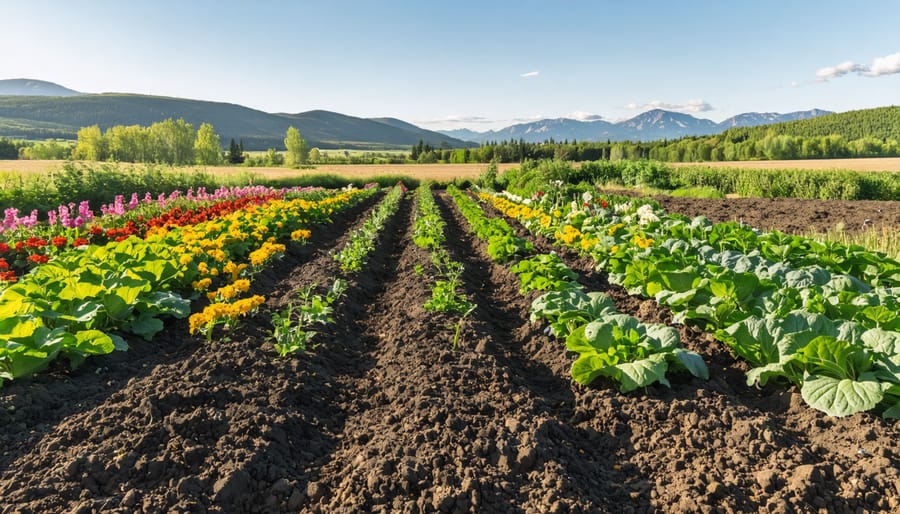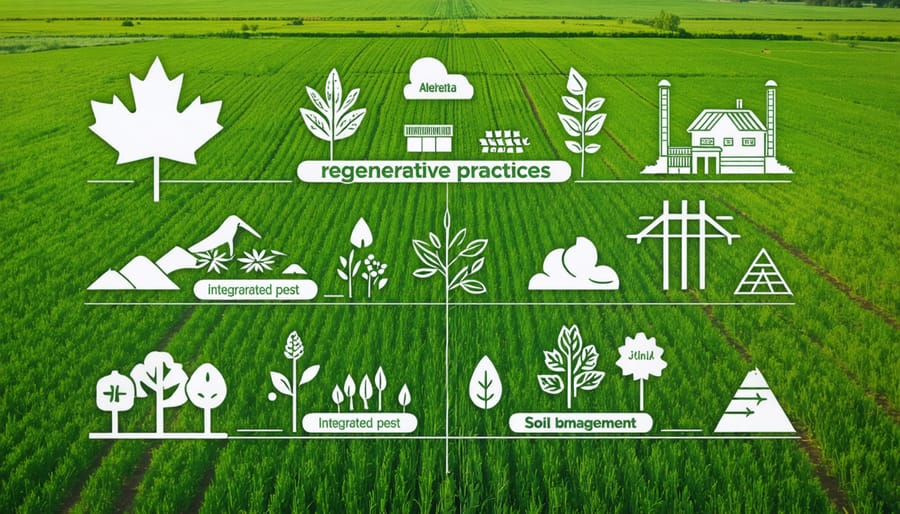Transform your soil’s potential with biochar, agriculture’s ancient solution to modern farming challenges. This carbon-rich material, created through pyrolysis of organic matter, fundamentally alters soil composition while sequestering carbon for centuries. Canadian farmers across Alberta are reporting up to 30% yield increases after incorporating biochar into their regenerative agriculture practices.
Unlike traditional soil amendments, biochar creates a permanent, porous structure that houses beneficial microorganisms, retains water, and stabilizes nutrients. It’s particularly effective in Alberta’s prairie soils, where studies show it can reduce fertilizer requirements by 20-25% while improving drought resilience.
What makes biochar revolutionary is its dual impact: enhancing agricultural productivity today while building soil health for future generations. As climate challenges intensify, this technology offers Canadian farmers a practical path to sustainable intensification, combining traditional wisdom with modern scientific understanding.
For farmers seeking reliable, long-term solutions to soil health and productivity, biochar represents more than just another soil amendment – it’s a cornerstone of regenerative agriculture that aligns economic benefits with environmental stewardship.
Why Alberta Farmers Are Turning to Biochar
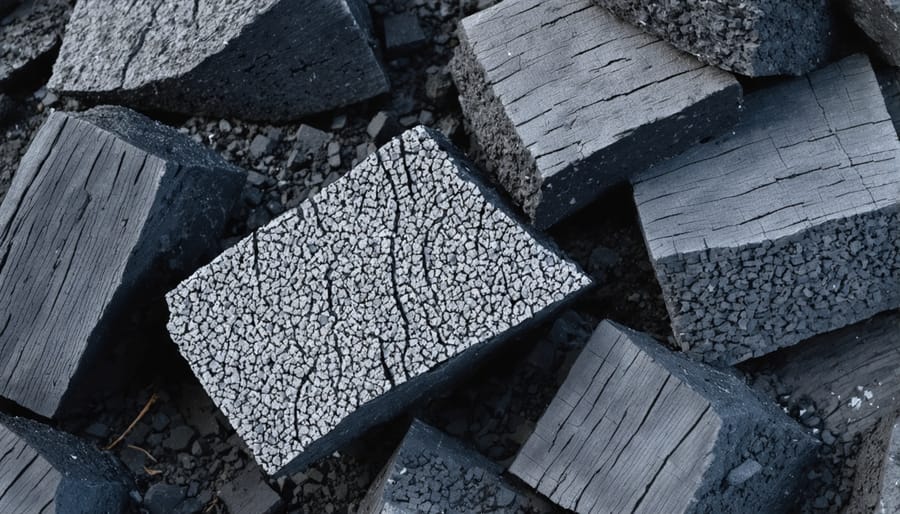
Soil Health Enhancement
Biochar’s remarkable ability to revitalize depleted soil makes it a game-changer for Alberta farmers facing challenging soil conditions. When incorporated into farmland, biochar creates a honeycomb-like structure that dramatically improves soil porosity and water retention. This enhanced structure allows roots to penetrate more easily and creates beneficial spaces for essential soil microorganisms.
The porous nature of biochar particles acts like a natural sponge, holding up to five times their weight in water and reducing irrigation needs by 15-30%. For Prairie farmers dealing with moisture management challenges, this water-retention capability can make a significant difference during dry spells.
Biochar also excels at nutrient retention, preventing valuable fertilizers from leaching away. Its high surface area and negative charge act like a magnet for nutrients, keeping them available in the root zone where crops need them most. Many Alberta farmers report reducing their fertilizer applications by 20-25% after incorporating biochar, while maintaining or improving yields.
These improvements in soil structure and fertility aren’t temporary – biochar can persist in soil for hundreds of years, making it a long-term investment in your farm’s future.
Carbon Sequestration Benefits
Biochar’s potential for carbon sequestration in agriculture represents one of its most significant environmental benefits. When incorporated into soil, biochar can lock carbon away for hundreds, even thousands of years, effectively removing it from the atmosphere. For Alberta farmers, this presents a unique opportunity to contribute to climate change mitigation while improving their soil health.
Studies conducted at the University of Alberta show that one hectare of farmland treated with biochar can sequester between 3 to 5 tonnes of carbon dioxide equivalent annually. This carbon storage is particularly stable in our prairie soils, where cold winters help preserve the biochar structure.
What makes biochar particularly effective is its porous nature and resistance to decomposition. Unlike other organic matter that breaks down relatively quickly, biochar remains stable in the soil, providing long-term carbon storage while simultaneously improving soil structure and fertility. For Canadian farmers participating in carbon credit programs, biochar application offers a measurable way to demonstrate their contribution to climate solutions while potentially accessing additional revenue streams through carbon markets.
Producing and Applying Biochar: A Practical Guide
Making Biochar on Your Farm
Creating biochar on your farm is more straightforward than you might think, and many Alberta farmers have successfully integrated production into their operations. The most common method is using a pyrolysis kiln, which can range from simple barrel systems to more sophisticated continuous-feed units.
For smaller operations, a basic TLUD (Top-Lit UpDraft) system can be built using two metal drums, with costs typically under $500. These systems can process about 200-300 kg of biomass per day. Larger farms might consider investing in commercial kilns, which can handle 1-2 tonnes daily and offer better temperature control.
The process starts with collecting suitable biomass – wood waste, crop residues, or even livestock bedding. The material should be relatively dry (moisture content below 20%) and chopped into consistent pieces about 5-10 cm in length. During pyrolysis, temperatures need to reach 350-550°C for optimal biochar production.
Essential equipment includes:
– Heat-resistant containers or kilns
– Temperature monitoring devices
– Safety equipment (gloves, masks, fire extinguishers)
– Storage containers for finished biochar
– Water source for quenching
Many Alberta farmers have found success by scheduling biochar production during slower seasons, particularly winter months when other farm activities are reduced. Remember to check local regulations regarding open burning and obtain necessary permits before starting production.
A growing number of regional farming cooperatives are also sharing equipment and knowledge, making it more accessible for smaller operations to begin biochar production. Consider connecting with local agricultural extension offices or farming groups to learn from others’ experiences and potentially share resources.
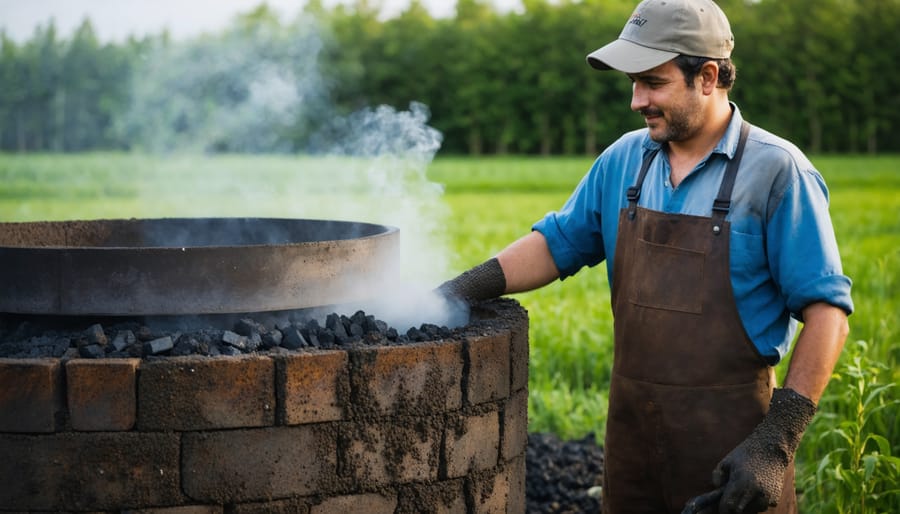
Application Techniques and Timing
The success of biochar application largely depends on proper timing and technique. For best results in Alberta’s climate, apply biochar in early spring before seeding or in fall after harvest when soil moisture levels are optimal. Aim for soil temperatures above 10°C to promote microbial activity and enhance biochar integration.
Before application, condition your biochar by mixing it with compost or liquid manure for 2-4 weeks. This pre-charging process helps biochar absorb nutrients and beneficial microorganisms, making it immediately effective once incorporated into the soil. A typical application rate ranges from 5-10 tonnes per hectare, though rates can vary based on soil type and crop requirements.
For row crops, incorporate biochar into the top 15-20 cm of soil using conventional tillage equipment. Many Alberta farmers have found success using their existing machinery, such as disc harrows or cultivators, eliminating the need for specialized equipment. In no-till operations, consider applying biochar in furrows during seeding or as a top dressing mixed with compost.
For smaller operations or market gardens, blend biochar with existing soil amendments at a ratio of 10-20% biochar by volume. When transplanting, add a handful of charged biochar directly to planting holes to support root development.
Remember to maintain adequate soil moisture during and after application. Dry biochar can temporarily bind soil moisture, so timing applications before expected rainfall or irrigation events is beneficial. Monitor soil pH levels after application, as biochar typically causes a slight increase in soil alkalinity, which may require adjustment in subsequent fertility programs.
First-time users often start with test plots of 1-2 hectares to observe results and refine their application methods before scaling up to larger areas.
Real Results: Alberta Success Stories
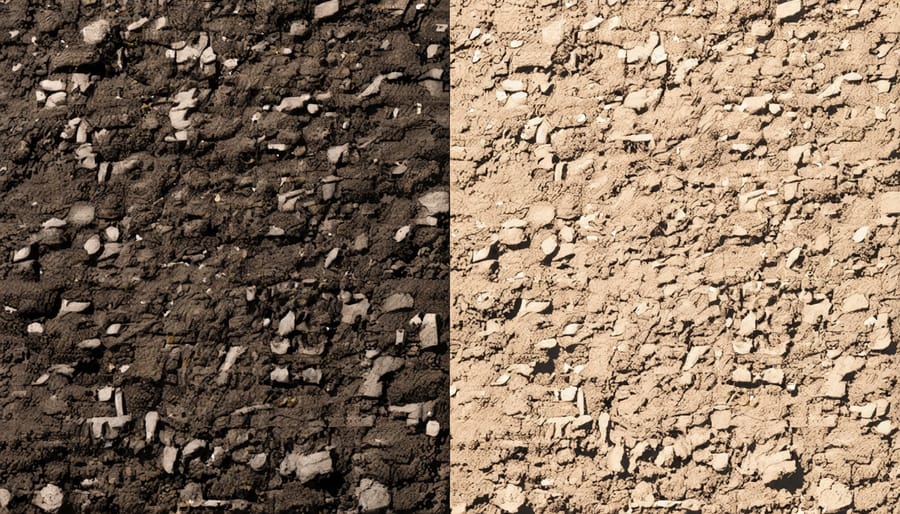
Mixed Crop Farm Success
James Wilson, a third-generation farmer from Red Deer County, Alberta, has been implementing biochar on his 400-hectare mixed crop operation since 2019. “I was skeptical at first,” Wilson admits, “but after seeing the results in our soil quality and crop yields, I’m completely sold on biochar.”
Wilson initially tested biochar on a 40-hectare plot of canola, applying 10 tonnes per hectare mixed with his regular fertilizer application. The results were promising enough to expand the practice across his entire operation over the next two growing seasons.
“We’ve seen a 15% increase in yield across our canola and wheat crops,” Wilson reports. “But what’s really impressive is how the soil holds moisture now. During the dry spell in 2021, our biochar-treated fields showed significantly better drought resistance than neighboring farms.”
The farm’s soil tests have shown a 30% increase in organic matter content and improved nutrient retention. Wilson estimates he’s reduced his fertilizer use by 20% while maintaining productivity. “The initial investment in biochar was substantial,” he acknowledges, “but we’re seeing returns through reduced input costs and better yields.”
Wilson now produces his own biochar using agricultural waste from his operation, making the practice more economically sustainable. He hosts regular field days for local farmers interested in biochar implementation, sharing his experiences and lessons learned.
Livestock Integration
Canadian ranchers are discovering innovative ways to integrate biochar into their livestock management practices, particularly in manure handling systems. By adding biochar to animal bedding and manure collection areas, farmers are effectively creating enriched compost that doubles as a powerful soil amendment.
In Alberta, several cattle operations have reported success with a layering technique where biochar is spread in barn stalls and feeding areas. The biochar absorbs excess moisture and reduces ammonia odours while capturing valuable nutrients from animal waste. This combined material, when properly aged, creates a nutrient-rich fertilizer that’s more stable and effective than traditional manure alone.
Many producers are using roughly 10% biochar by volume in their manure management systems. This ratio has shown promising results in both dairy and beef operations across the prairies. The practice not only improves animal comfort but also reduces the environmental impact of livestock operations by minimizing nutrient leaching and greenhouse gas emissions.
Local success stories include the Watson Family Farm near Red Deer, where implementing a biochar-manure system has reduced their fertilizer costs by 30% while improving soil organic matter content in their pastures. These integrated systems demonstrate how biochar can bridge the gap between livestock and crop production, creating more sustainable and profitable farming operations.
Economic and Environmental Returns
Cost Analysis and ROI
Implementing biochar in your agricultural operation requires careful consideration of both upfront costs and long-term returns. Initial investments typically include biochar material ($500-800 per tonne), application equipment, and labor costs. For a typical 160-acre Alberta farm, first-year implementation costs range from $15,000 to $25,000, depending on application rates and existing equipment availability.
However, the soil improvement economic benefits become evident within 2-3 growing seasons. Alberta farmers report 15-30% yield increases in various crops, particularly in drought-prone areas. Additional revenue streams include carbon credit opportunities, with current rates offering $30-45 per tonne of sequestered carbon.
Cost-saving benefits include reduced fertilizer needs (20-30% decrease after initial application), improved water retention leading to lower irrigation costs, and decreased soil amendment requirements. Based on current market prices and documented yield improvements, most farmers achieve ROI within 3-5 years.
Real-world example: The Jensen family farm in Red Deer County invested $20,000 in biochar implementation in 2019. By 2022, they reported net returns of $35,000 through combined yield increases, reduced input costs, and carbon credits. Their success demonstrates the viable economic model of biochar adoption in Canadian agriculture.
Environmental Impact Metrics
Recent studies across Alberta farms have shown significant environmental improvements through biochar implementation. Data collected from participating farms in Red Deer County reveals that biochar-amended soils reduced water consumption by 15-20% compared to conventional fields, primarily due to enhanced water retention capabilities.
Carbon sequestration measurements from test plots in the Peace Region demonstrated that fields treated with biochar stored an average of 2.5 tonnes of carbon per hectare annually. This represents a threefold increase in carbon storage compared to untreated fields, contributing meaningfully to greenhouse gas reduction efforts.
Soil testing from Lethbridge area farms showed a 30% decrease in nitrogen leaching in biochar-treated fields, resulting in improved groundwater quality and reduced fertilizer requirements. Additionally, methane emissions from livestock operations using biochar as a feed supplement decreased by approximately 12%, according to a two-year study conducted by Alberta Agriculture.
Local farmers report a notable reduction in soil erosion, with biochar-treated fields showing 40% less topsoil loss during wind events compared to conventional fields. The enhanced soil structure has also led to improved drainage patterns, with participating farms experiencing 25% less water runoff during heavy rainfall events.
These metrics demonstrate biochar’s substantial role in promoting environmental sustainability while maintaining productive agricultural operations. The data continues to be monitored through ongoing collaboration between farmers and agricultural research stations across the province.
As we’ve explored throughout this guide, biochar presents a compelling opportunity for Canadian farmers to enhance soil health, increase crop yields, and contribute to climate-smart agriculture. The evidence from Alberta farm trials shows that biochar can improve water retention by up to 30% and increase crop yields by 15-20% when properly implemented.
Moving forward, the key to successful biochar integration lies in starting small and scaling gradually. Begin with test plots of 1-2 hectares to understand how biochar interacts with your specific soil conditions and crop types. Connect with local agricultural extension offices and join farmer networks that are already experimenting with biochar applications.
Remember that biochar is not a quick fix but rather a long-term investment in your soil’s health. The initial costs of $500-800 per tonne can be offset by reduced fertilizer needs and improved crop resilience over time. Many Canadian farmers have found success by producing their own biochar, which can significantly reduce implementation costs.
Take advantage of available resources and support systems. The Alberta Biochar Initiative offers workshops and technical assistance, while several agricultural cooperatives now include biochar in their soil amendment programs. By working together and sharing experiences, we can build a more sustainable and resilient agricultural future for Canada.
The journey to biochar adoption may seem challenging, but the potential benefits for your farm’s productivity and environmental impact make it worth considering. Start your biochar journey today with informed decisions and community support.




